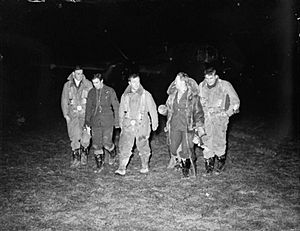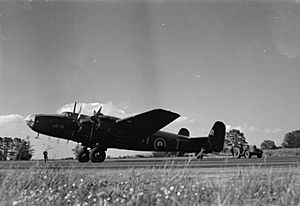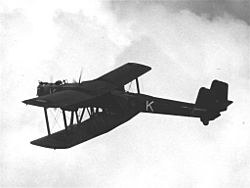No. 102 Squadron RAF facts for kids
Quick facts for kids No. 102 (Ceylon) Squadron RAF |
|
|---|---|

No. 102 Squadron badge
|
|
| Active | 9 Aug 1917 – 3 Jul 1919 1 Oct 1935 – 28 Feb 1946 20 Oct 1954 – 20 Aug 1956 1 Aug 1959 – 27 Apr 1963 |
| Country | |
| Branch | |
| Nickname(s) | Ceylon "Morecambe's 'own' Squadron" (Unofficial) |
| Motto(s) | Latin: Tentate et Perficite ("Attempt and achieve") |
| Insignia | |
| Squadron Badge heraldry | On a demi-terrestrial globe a lion rampant guardant holding in the forepaws a bomb |
| Squadron Codes | TQ (Apr 1939 – Sep 1939) DY (Sep 1939 – May 1945) EF (May 1945 – Feb 1946) |
No. 102 Squadron was a special group of planes and pilots in the Royal Air Force (RAF). They flew planes that dropped bombs at night during the First World War and bigger bombs during the Second World War. After these wars, they briefly helped transport people. Later, they became a unit that used powerful missiles.
Contents
The Early Years: First World War
How the Squadron Started
No. 102 Squadron began in August 1917. It was formed at Hingham, Norfolk to fly night bombing missions. Their first planes were the RAF F.E.2b and F.E.2d models.
Fighting in France
The squadron soon moved to France. Their main job was to attack German targets at night. They focused on railway stations, tracks, and trains. These attacks helped disrupt enemy supplies. After the First World War ended, the squadron returned to England in March 1919. It was officially closed down on 3 July 1919 at RAF Lympne.
Between the Big Wars
Reforming the Squadron
No. 102 Squadron was started up again on 1 October 1935. This happened at RAF Worthy Down. The new squadron was formed using people and equipment from another group, 'B' Flight of 7 Squadron. They continued their role as a night bomber squadron. Their first planes this time were the Handley Page Heyford.
Joining a New Group
In October 1938, the squadron became part of the new No. 4 Group of Bomber Command. They were based at RAF Driffield in Yorkshire. Around this time, they also got new planes, the Armstrong Whitworth Whitley.
No. 102 Squadron in World War II
Starting Missions in the War
The squadron was very active right from the start of the Second World War. On the night of 4 to 5 September 1939, they flew over Germany dropping leaflets. These leaflets were messages, not bombs.
Helping Protect Ships
From September to October 1940, the squadron briefly helped RAF Coastal Command. They spent six weeks flying from RAF Prestwick. Their job was to protect convoys of ships at sea. After this, they went back to their bombing missions.
Bombing Missions and New Planes
Records show that on 27 November 1940, two Whitley Mk.Vs planes flew from Topcliffe. They bombed "docks and shipping" at Le Havre. One plane did not return, but the other successfully dropped its bombs.
By February 1942, the squadron was "adopted" by Sri Lanka, which was then called Ceylon. This meant Ceylon helped fund the squadron. Around this time, their Whitleys planes were replaced by the larger Handley Page Halifax bombers.
Continued Night Raids
For the next three years, the squadron continued to fly night missions. They took part in major bombing raids over Germany. These included the famous "thousand bomber raids." In 1944, they attacked railway targets in France. This was to prepare for the invasion of Europe.
After the War: Transport and Missiles
Becoming a Transport Squadron
On 8 March 1945, the squadron changed roles. They became part of RAF Transport Command. In September 1945, they got new planes, the Consolidated Liberators. They were based at RAF Bassingbourn. Their main job was to bring troops and prisoners of war back from India.
Once this work was finished, the squadron moved to RAF Upwood on 15 February 1946. They were then officially closed down on 28 February 1946. Their number was given to 53 Squadron.
Nuclear Strike Bombers
No. 102 Squadron was reformed again on 20 October 1954. This time, they were part of RAF Germany. They became a nuclear strike bomber squadron. They flew the English Electric Canberra B.2 plane from RAF Gütersloh. They were closed down again on 20 August 1956. Their number was then given to 59 Squadron.
Using Strategic Missiles
The squadron was reformed one last time in August 1959. They were called No. 102 (SM) Squadron RAF, with "SM" meaning "Strategic Missile." They were equipped with three PGM-17 Thor ballistic missiles. Each missile carried a powerful nuclear warhead. This was part of a plan between the UK and US to deter attacks, called Project Emily. The squadron was based at RAF Full Sutton in Yorkshire. Like other Thor squadrons, it was closed down on 27 April 1963.
Planes and Missiles Used by No. 102 Squadron
No. 102 Squadron used many different types of aircraft and even missiles throughout its history. Here's a list of what they operated:
| From | To | Aircraft | Variant |
|---|---|---|---|
| Aug 1917 | Jul 1919 | Royal Aircraft Factory FE.2 | FE.2b and 2d |
| Oct 1935 | Apr 1937 | Handley Page Heyford | Mk.II |
| Dec 1935 | May 1939 | Handley Page Heyford | Mk.III |
| Oct 1938 | Jan 1940 | Armstrong Whitworth Whitley | Mk.III |
| Nov 1939 | Feb 1942 | Armstrong Whitworth Whitley | Mk.V |
| Dec 1941 | May 1944 | Handley Page Halifax | Mk. II |
| May 1944 | Sep 1945 | Handley Page Halifax | Mks.III and IIIa |
| Jul 1945 | Sep 1945 | Handley Page Halifax | Mk.VI |
| Sep 1945 | Feb 1946 | Consolidated Liberator | Mks.VI and VIII |
| Oct 1954 | Aug 1956 | English Electric Canberra | B.2 |
| Aug 1959 | Apr 1963 | PGM-17 Thor Intermediate-range ballistic missile | SM.75 |
Interesting Facts About No. 102 Squadron
- Pilot Officer Alfred B. Thompson was a pilot in 102 Squadron. On 9 September 1939, he became the first Canadian captured in the Second World War. He was also the longest-held Canadian prisoner of war ever. He even took part in the famous Great Escape (Stalag Luft III escape), being the 68th person to escape through the tunnel.
- Leonard Cheshire was a Pilot Officer with 102 Squadron starting in July 1940. In November 1940, he received a special award, the DSO. He earned it for flying his badly damaged Whitley plane safely back to base.
- The island of Ceylon "adopted" the squadron in February 1942. This meant they helped pay for planes for the squadron to use.
- The flight log book of Flight Lieutenant Leonard Todd DFC from August 1943 shows how often and how far 102 Squadron flew its missions.
See also
- List of Royal Air Force aircraft squadrons
- List of UK Thor missile bases






